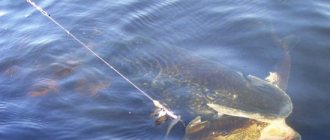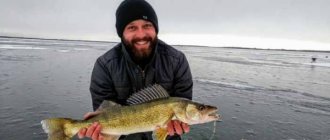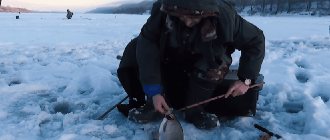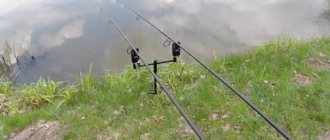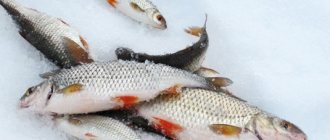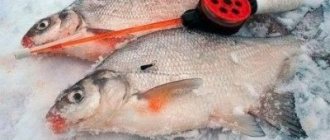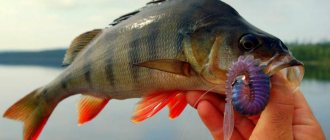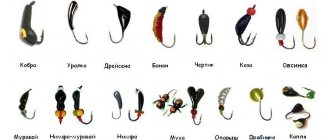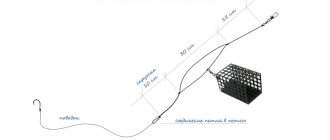☸ Briefly about the varieties of donoks
Bottom tackle has come a long evolutionary way. It all started with a primitive hook, to which some inventive fisherman came up with the idea of tying a piece of thin elastic band. This is how a donk with a rubber shock absorber appeared, which served faithfully for decades. Many people still use it now.
But progress moved inexorably forward, and today bottom tackle is a perfected tool, equipped with a reel and an electronic bite alarm. It bears little resemblance to its prototype, but the principle of operation is absolutely the same: casting, delivering bait to the bottom and waiting for the approach of fish feeding in the bottom horizon. At the very top of the evolution of bottom gear is the feeder, but this is a separate topic. Moreover, in cold spring water, fish react poorly to odors, so it is still better to fish with a donk in the classic version, that is, without a feeder.
There are also donks for fishing from a boat. For example, a ring with a sinker in the shape of a steering wheel, designed for fishing in the current. First, a bag of bait is lowered to the bottom, then a lead ring with leashes and hooks is sent down along its cord. The water flow gradually washes the food out of the bag, and the leashes are pulled in the same direction. What can I say, simple and effective! The ringer is not cast by hand or with a swing of the rod, but it is also a bottom tackle, since it catches fish from the bottom. True, it is more suitable for summer fishing, because you won’t last long in a boat in the cold spring wind.
☸ What does a modern donka consist of?
Unlike the old-fashioned reel with a line as thick as a match, the current donka is a more convenient tackle to use. It consists of several elements.
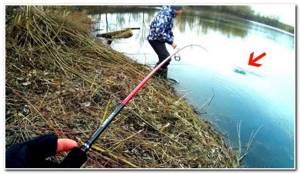
⚓ Rod
It doesn’t have to be expensive and elegant; you can use any durable form made of cheap material with a length of 2 to 4 meters. The length is selected depending on how far you plan to throw the tackle (the longer, the further the tackle flies). In addition, a long rod allows you to reduce the impact of water flow on the fishing line if fishing takes place on a fast river.
⚓ Reel
A budget model will do, unless of course the fisherman is aiming for a serious trophy. In this case, it is better to give preference to a high-quality product from a well-known manufacturer that will not let you down in the fight against large, strong fish. For the same reason, it is advisable to take a reel with a spool that can hold at least 150 meters of fishing line. With such a supply, you can let the trophy fish “take a walk”, tire it out and bring it safely to shore. The sensitivity of the clutch in bottom fishing does not play a special role, since thin equipment is not used. Its location is much more important. It is more convenient to adjust the friction brake, which is located at the rear.
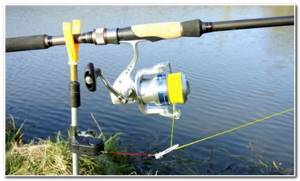
⚓ Fishing line
In this type of fishing, monofilament is often used, often quite thick. For example, a donkey for catfish is equipped with a fishing line with a diameter of at least 0.4 mm. To catch small fish, you can use braided line; it is more sensitive, so it transmits the bite better.
⚓ Sinker
The most important element of bottom gear, the weight and shape of which depend on many factors, such as the strength of the current, the nature of the bottom surface and others. Usually these are lead weights purchased at a fishing store or cast yourself. Fishermen practice three installations of bottom equipment. The first is that the leashes are located above the sinker, tightly fixed to the end of the main fishing line. Second, the main line passes through a through hole in the weight and is connected to the leash(s) using a swivel. Third - the sinker is installed between the leashes on a separate 40-centimeter undergrowth.
⚓ Hooks
They are selected for bait, with the exception of fishing for live bait. For carp species (roach, silver bream, white bream, bream), it is better to use thin wire hooks; they are less frightening to cautious fish. It is clear that these are not suitable for catching catfish or burbot, since these strong predators can easily bend or break them. Here you will need more powerful hooks with a long shank.
⚓ Alarm
Bells and other noisy devices are used.
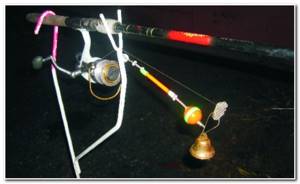
Recipe No. 1
This bait is excellent for feeder, float and bottom fishing for roach. It is very easy to make and does not require special skills. We will need a package of millet. We make sure that the grains are large and have a bright yellow color. Millet can be boiled in water or steamed in boiling water. You will need 3 cups of water per 1 cup of millet. Cook over medium heat for 8-10 minutes, stirring the porridge occasionally. It is better to use a metal pan, as the cereal does not stick to it as much.
For our case, millet is considered ready if it has retained its shape but increased in size. When pressed, the grains are easily compressed. After 30 minutes, add a few packets of vanillin to the millet and pour the finished product into a canvas bag and put it in the refrigerator.
When fishing, about 0.5 kg of breadcrumbs and the same amount of store-bought bait for roach or bream are added to the millet. If we make balls, then we add soil to the composition, approximately 30% of the total amount of the bait mixture.
You can add this type of barberry liquid flavor to the bait:
It is very concentrated, so we literally add 5-6 drops. During the fishing process, if we see that the smell is leaving, you can add a few drops.
This bait option is suitable for the warm season. It has a rich smell and a sweet taste - everything the roach likes. Millet has good stickiness and bright color. Together with the bulk components, it disintegrates well and creates an attractive bait spot.
☸ Where to fish with donka
Of course, the choice of location depends on what kind of fish the fisherman is targeting. Each species has its own favorite areas on the pond, and if there are no bites, it means that it was chosen incorrectly. Burbot and catfish practically do not emerge from deep holes; bream trails can also pass at depth. Some fish like to stand on riffles, others prefer to stay behind them. River bends, which are characterized by steep banks and whirlpools beneath them, should be considered promising. There is every chance to get a trophy here.
Where else can underwater inhabitants be concentrated? In early spring, representatives of the carp family are looking for both warmth and food, so they gather where the water warms up faster and where meltwater brings a lot of food. These can be the confluence of streams and small rivers or a well-warmed bay. With the appearance of the first vegetation in the coastal zone, small and medium-sized individuals will move here, but their large relatives will remain at depth. This must be taken into account when fishing with donka in the spring.

Knowledge of the bottom topography of the reservoir is of great importance for the correct choice of location. Underwater inhabitants do not linger in areas with a clean and flat bottom, like a board; they are attracted by various irregularities, stones, snags, and submerged tree branches. Peaceful fish seek shelter here, and predators have the opportunity to ambush them.
☸ Features of bottom fishing for bream, catfish and burbot
Experienced bottom fishers do not waste time fishing for small fish; their goal is large prey. How does she end up in their cage?
⚓ Bream
Catching this beauty in the spring is not at all easy. After winter, it is still weak, so it stays in a moderate current, where energy expenditure to fight it is minimal. It prefers a muddy bottom, in which it searches for various living creatures.
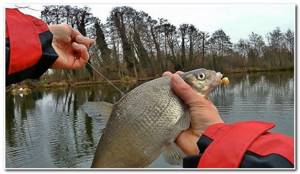
Standard bottom tackle is not equipped with a feeder, and successful catching of bream on a bottom in the spring without feeding is almost impossible. If there are bites, they will be random. That is why the bait has to be delivered to the fishing point manually or using a special slingshot. There are serious requirements for the bait itself, because bream at this time of year is very picky about food. It should attract fish, and not saturate or scare away with a pungent odor. Ideally, this is any porridge mixed with clay taken from a reservoir in a 1:1 ratio, to which components of animal origin must be added. With the exception of sunflower cake, no strong odorous additives are used.
In the first half of spring, bream fish for bloodworms, maggots and worms. If the bite is active, you can offer him combinations of the listed baits - so-called sandwiches. Closer to summer, as the water warms up, he gradually begins to become interested in plant baits: pearl barley, corn, peas.
⚓ Som
In March, this giant, as a rule, does not show itself yet, but in April it can already be successfully caught in many reservoirs. The choice of location depends on weather conditions. If it is cold, the predator continues to remain near the wintering pits, and in good warm weather it can go out to bask in the reaches and shallows. Anglers only have a few weeks to enjoy exciting catfish fishing as catfish begin to spawn in May.
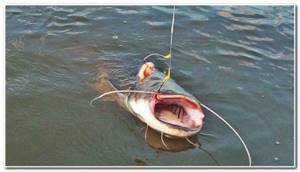
To catch a mustachioed giant, you should take at least five or six donks and place them in promising places. The main thing is that they are in the fisherman’s field of vision and at a distance from which the sound of the bell can be heard, otherwise you can lose the tackle.
The bait for catching catfish in the spring on a donk are worms (crawlers, dung and others), leeches, shell meat, fry, crustaceans and frogs. Almost everything on this list is mined directly from the reservoir.
⚓ Burbot
This is another river inhabitant that can be effectively caught with bottom tackle in the spring. It begins to actively peck very early, immediately after the river is free of ice. To fish for burbot, it is not at all necessary to have a large supply of fishing line on the reel, since long casts are not required for such fishing. The fact is that it avoids the fast spring current, so it stays close to the shore if the depth allows. His favorite place is a whirlpool created by two multidirectional jets.

The best bait for catching burbot in the spring on a donk will be small bottom fish (minnow, ruffe, loach), you can also use cut fish, including store-bought frozen ones (for example, capelin).
Burbot is a pronounced nocturnal predator, so many anglers leave baits overnight and “harvest” in the morning. In this case, they need to be securely fastened to the shore.
Roach fishing tackle, hooks
There is a widespread opinion that saving on hooks costs more. And indeed it is. The normal performance of a good bottom roach hook is: one bite – one fish in the cage. However, to be more objective, for every ten bites there should be nine fish in the cage.
If a significant number of roach bites are not realized, especially if failures are common during fishing, then this hook is not suitable for roach.
Choosing a roach hook can begin with choosing the optimal shape. The shape of the hook should be well suited mainly for vegetable attachments (various doughs, star pasta, etc.). The size of the hook depends on the size of the bait, the size of the fish being caught and partly on the type of bait. And in each specific case you will have to select the optimal hook size. Moreover, the difference in rooms can be significant: from N18 to N8. If you take a hook smaller than what is required today, then when hooking it will often jump out of the fish’s mouth; if larger, then the percentage of empty bites will increase. To some extent, N10 can be considered a universal number on the river, but this is for heavy roach. For roaches weighing up to 150 grams, N12-14 is better, and with small baits, smaller hooks N16-18. When catching large roach on the bottom is greatly hampered by bleak and small silver bream, the N8 hook can help out, on which the roach sits quite normally.

